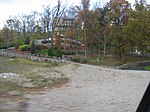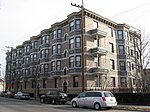University of Cincinnati College of Applied Science
Educational institutions established in 1828Greater Cincinnati school stubsUniversity of Cincinnati
The University of Cincinnati College of Applied Science (CAS) was an applied science college at the University of Cincinnati in Cincinnati, Ohio. Organized as the Ohio Mechanics Institute (OMI) in 1828, it merged with UC in 1969 and was renamed the OMI College of Applied Science in 1978. On September 22, 2009, CAS merged with the College of Engineering to create the College of Engineering and Applied Science.
Excerpt from the Wikipedia article University of Cincinnati College of Applied Science (License: CC BY-SA 3.0, Authors).University of Cincinnati College of Applied Science
Victory Parkway, Cincinnati East Walnut Hills
Geographical coordinates (GPS) Address Nearby Places Show on map
Geographical coordinates (GPS)
| Latitude | Longitude |
|---|---|
| N 39.1217 ° | E -84.4844 ° |
Address
College of Applied Sciences Science Building
Victory Parkway
45206 Cincinnati, East Walnut Hills
Ohio, United States
Open on Google Maps







